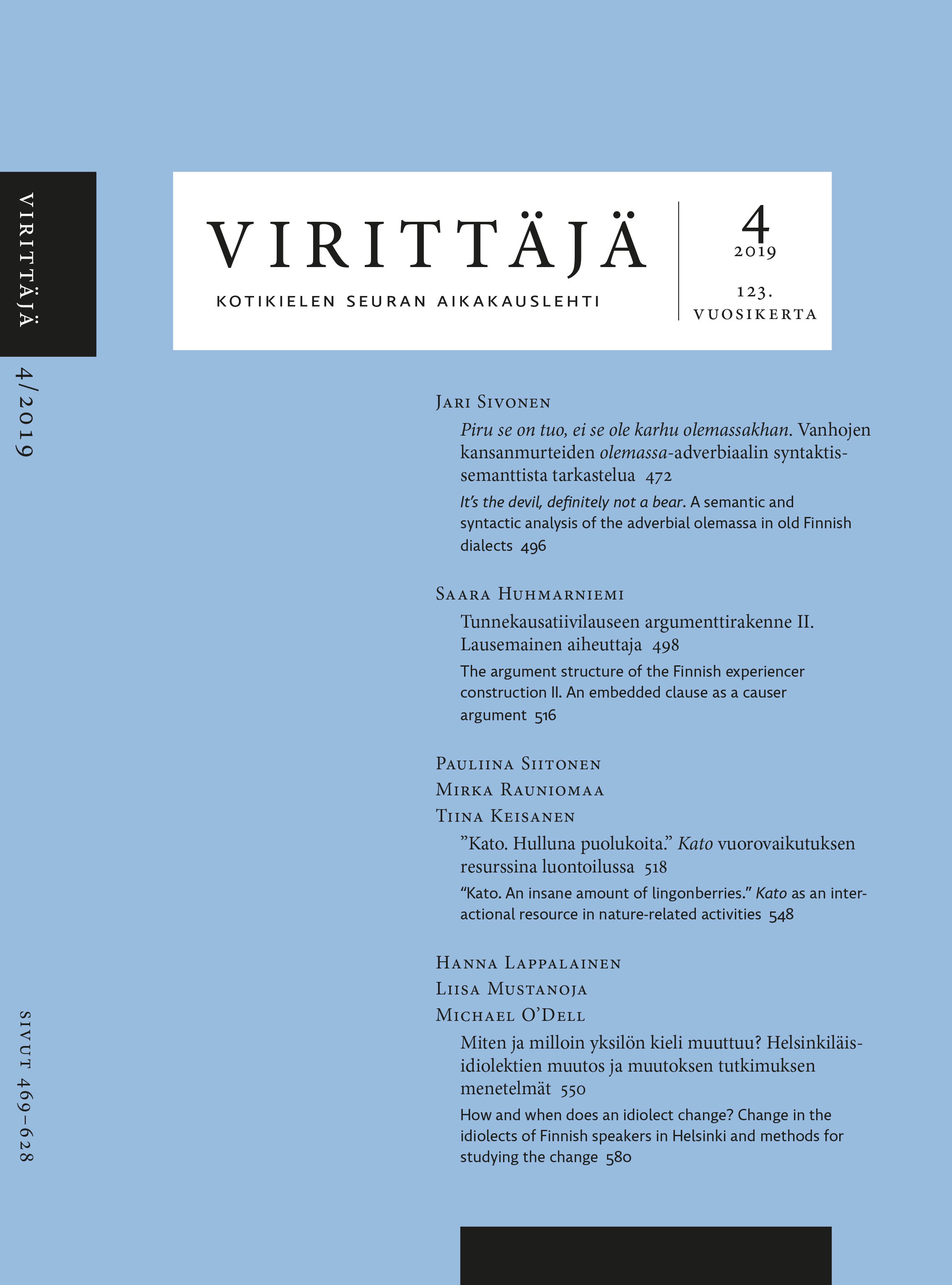Tunnekausatiivilauseen argumenttirakenne II
Lausemainen aiheuttaja
Abstrakti
Suomen tunnekausatiivilause muodostuu tunnetta ilmaisevasta verbistä, johon liittyy tyypillisesti partitiivimuotoinen kokija, aiheuttaja tai kumpikin. Aiheuttaja voi olla paitsi nominatiivimuotoinen NP myös lausemainen, kuten A-infinitiivi, kun-lause, että-lause tai alisteinen kysymyslause. Tämän artikkelin tavoitteena on osoittaa generatiivisen syntaksin työkaluja käyttäen, että A-infinitiivi ja että-lause sijoittuvat tunnekausatiivilauseen argumenttirakenteessa komplementtipositioon, kun taas aiheuttajana toimiva kun-lause voi sijoittua joko adjunkti- tai komplementtipositioon. Lisäksi artikkelissa esitetään Suomi24-korpusaineiston perusteella, että tunnekausatiivien luokittelu tunne- ja tuntemusverbeihin korreloi lausemaisen aiheuttaja-argumentin yleisyyden kanssa.
Artikkeli on toinen osa kahden artikkelin sarjasta. Ensimmäisessä osassa esitettiin, että aiheuttajana toimiva NP asettuu rakenteessa tyypillisesti ylemmäs kuin kokija. Koska lausemainen aiheuttaja asettuu välttämättä komplementtiin ja alemmas kuin kokija, tunnekausatiivilauseen argumenttirakenne näyttää siis vaihtelevan ainakin aiheuttaja-argumentin tyypin mukaan.
The argument structure of the Finnish experiencer construction II: An embedded clause as a causer argument
This paper investigates the Finnish experiencer construction, which involves a psychological predicate and two optional arguments: the nominative causer and the partitive experiencer. The causer argument can be clausal, such as the A infinitive, the kun clause, a finite clause headed by the complementizer että, or an embedded interrogative clause.
Mua jännittää kertoa tämä sulle. (colloquial)
I.par excite.caus.pres.3sg tell.inf this.nom you.to
‘I’m excited to tell you about this.’
The aim of this paper is to show within the framework of generative syntax that the A infinitive and the finite complement clause occupy the complement position in the experiencer construction, while the kun clause may occupy either the adjunct or complement position. The syntactic analysis is complemented with a corpus analysis of a corpus taken from the Suomi24 online messaging site. The comprehensive Finnish grammar divides experiencer verbs into two classes: those that express emotion and those that express sensation. The corpus analysis shows that verb type correlates with the frequency of a clausal causer.
This article is the second in a series of two. The first article investigated constructions in which the causer argument was an NP. It demonstrated that the causer NP -occupies a higher position in the argument structure than the experiencer NP. In this -article, the author argues that a clausal causer occupies a lower position than the experiencer. This means that the experiencer construction has alternating argument structures for different types of causers.






